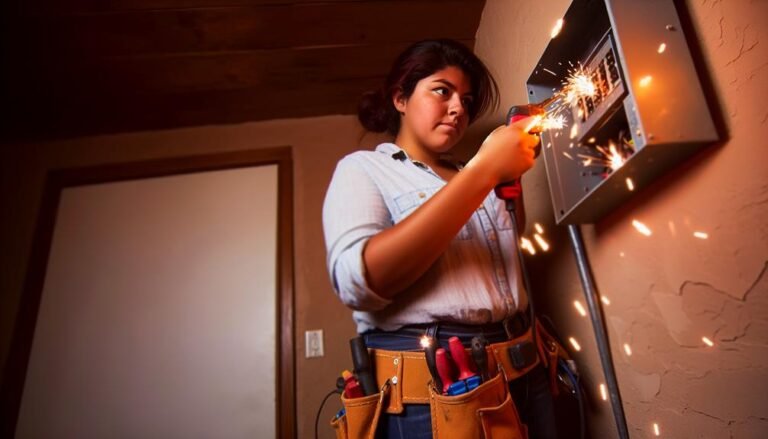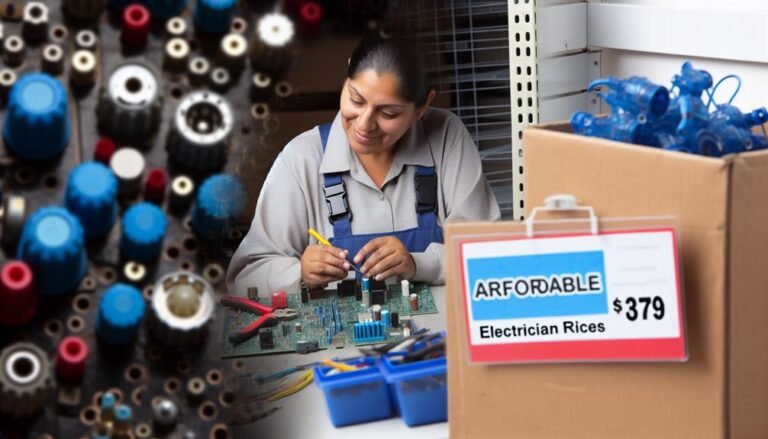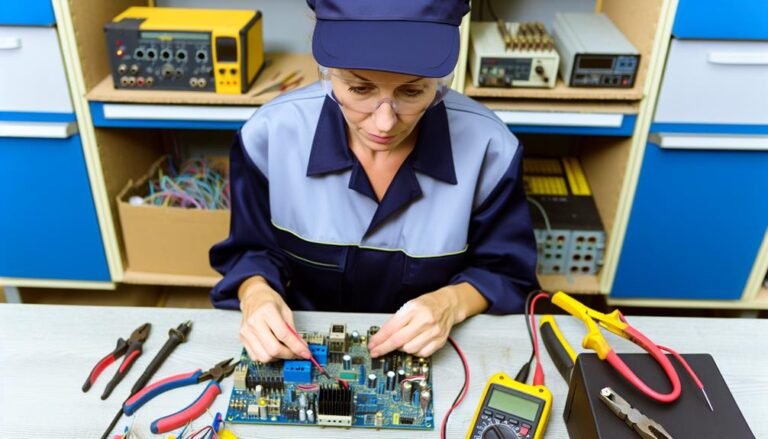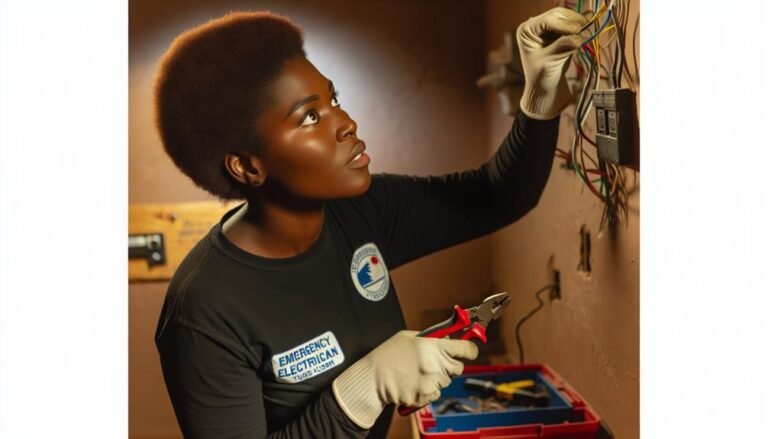Did you know that electrical fires account for approximately 51,000 residential fires each year in the United States? When faced with an electrical emergency in Tucson, it is crucial to know how to handle the situation safely and effectively.
From identifying the source of the problem to restoring power after an outage, these 12 essential tips will equip you with the knowledge and skills needed to address emergency electrical repairs. Whether you're a homeowner or a renter, understanding these tips could potentially save lives and prevent extensive damage to your property.
So, let's get started on this informative journey towards electrical safety and preparedness.
Key Takeaways
- Assess the situation and identify potential dangers before attempting any emergency electrical repairs.
- Always turn off the power supply by locating the main electrical panel and switching off the circuit breaker or removing the fuse.
- Use insulated tools and wear protective equipment like gloves and safety goggles to minimize the risk of electrical shock.
- If the repair task is beyond your skill level, it is important to call a professional electrician to ensure safety and proper repairs.
Safety Precautions for Emergency Electrical Repairs
When performing emergency electrical repairs, it's crucial to prioritize safety precautions to ensure the well-being of yourself and others around you. Identifying electrical hazards and preventing electrical accidents should be your top priority.
Start by assessing the situation and identifying any potential dangers. Look for exposed wires, damaged outlets, and faulty equipment. It's important to turn off the power supply before starting any repairs. Locate the main electrical panel and switch off the circuit breaker or remove the fuse corresponding to the area you'll be working on. This will prevent any accidental electric shocks or fires.
Use insulated tools and wear protective equipment, such as gloves and safety goggles, to minimize the risk of injury. Avoid working alone and have someone nearby who can assist you in case of an emergency. Ensure that the area is well-lit and free from any flammable materials.
Lastly, never attempt any repairs beyond your skill level. If you're unsure or uncomfortable with the task, it's best to call a professional electrician to handle the job.
Identifying the Source of the Electrical Problem
To identify the source of the electrical problem, carefully inspect the electrical system for any visible signs of damage or malfunction. Here are some steps you can take to help you identify common electrical problems and troubleshoot electrical issues:
- Start by checking the circuit breakers and fuses. Look for any that are tripped or blown, and reset or replace them if necessary. This is a common cause of electrical problems and can easily be resolved.
- Next, examine the outlets and switches. Look for any signs of damage, such as loose connections, burnt marks, or discoloration. Faulty outlets or switches can cause electrical issues and may need to be replaced.
- Inspect the wiring throughout your home. Look for any frayed or exposed wires, as well as any signs of overheating or burning. Faulty wiring can lead to electrical problems and should be addressed by a professional electrician.
- Finally, check any appliances or devices that may be causing the issue. Unplug them one by one and see if the problem persists. Faulty or malfunctioning appliances can sometimes cause electrical problems.
Shutting off the Power Supply
After identifying the source of the electrical problem, the next crucial step is to safely shut off the power supply. This is an essential safety measure that should always be followed before attempting any emergency electrical repairs. By cutting off the power, you eliminate the risk of electric shock and prevent further damage to the electrical system. To ensure a safe shutdown, follow these steps:
- Locate the main electrical panel: This is usually found in the basement, garage, or utility room. It contains the circuit breakers or fuses that control the power supply to your entire house.
- Open the panel cover: Use a screwdriver or a similar tool to remove the cover of the electrical panel. This will expose the circuit breakers or fuses.
- Turn off the main breaker or remove the main fuse: In the table below, you can find a guide on how to shut off the power supply based on the type of electrical panel in your home.
| Electrical Panel Type | Shutting Off the Power |
|---|---|
| Circuit Breaker Panel | Flip the main breaker to the "OFF" position. |
| Fuse Box Panel | Remove the main fuse from its holder. |
| Safety Switch Panel | Turn the switch to the "OFF" position. |
Using Proper Tools for Electrical Repairs
To ensure proper and safe repairs, it's essential to use the appropriate tools for electrical repairs. Using specialized equipment and taking proper precautions will help you handle electrical repairs effectively. Here are some key tools and precautions to keep in mind:
- Insulated Screwdrivers: These screwdrivers have a protective coating that prevents electrical shock. Always use them when working with live circuits to avoid accidents.
- Wire Strippers: These tools are designed to strip the insulation from electrical wires without damaging the conductors. Using the right size stripper will ensure clean and precise cuts.
- Voltage Tester: This tool helps you determine if a circuit is live or not. Before starting any electrical repair, use a voltage tester to ensure the power is off.
- Multimeter: This versatile tool allows you to measure voltage, current, and resistance in electrical circuits. It helps you diagnose and troubleshoot electrical problems accurately.
Remember to wear appropriate personal protective equipment, such as insulated gloves and safety glasses, to minimize the risk of electrical shock. Additionally, always follow safety guidelines and consult a professional if you're unsure about any aspect of the repair.
Dealing With Electrical Shocks or Burns
When faced with electrical shocks or burns, it's crucial to respond promptly and effectively to mitigate any potential harm or injury. Dealing with electrical burns requires immediate action to minimize damage and provide relief.
The first step is to ensure that the power source is disconnected to prevent further injury. Next, remove any clothing or jewelry near the burn area, as they can restrict blood flow and worsen the burn. Cool the burn with cold running water for at least 10 minutes to reduce pain and prevent further tissue damage. Avoid using ice or applying ointments, as they can cause more harm. Cover the burn with a sterile, non-stick dressing or clean cloth to protect it from infection. Seek medical attention as soon as possible for proper evaluation and treatment.
In the case of electrical shocks, it's essential to prioritize safety and provide first aid promptly. Ensure that the power source is turned off before approaching the person. Don't touch the person directly, as you may also get shocked. Instead, use a non-conductive object like a wooden broom handle to gently push the person away from the source of electricity.
Call emergency services immediately and perform CPR if necessary. Don't attempt to revive the person if they're still in contact with the electrical source. Remember, electrical shocks can be life-threatening, so it's crucial to seek professional medical help without delay.
Repairing or Replacing Faulty Electrical Outlets
If you're experiencing issues with a faulty electrical outlet, it's important to address the problem promptly and ensure it's repaired or replaced by a qualified professional. Faulty electrical outlets can be a safety hazard and may lead to electrical shocks or even fires.
To help you understand the process of repairing or replacing faulty electrical outlets, here are some essential tips:
- Troubleshooting faulty switches: Start by checking if the issue lies with the switch rather than the outlet itself. Test the switch by turning it on and off, and observe if it functions properly. If the switch is faulty, it may need to be replaced.
- Inspecting for damaged wires: Carefully examine the outlet for any visible signs of damage such as frayed or exposed wires. Damaged wires can pose a serious risk and should be repaired immediately. If you notice any damaged wires, it's crucial to call a professional electrician to handle the repair.
- Shutting off power: Before attempting any repairs, always turn off the power to the outlet at the breaker box. This will prevent any accidental electrical shocks while working on the outlet.
- Calling a qualified electrician: Repairing or replacing faulty electrical outlets should be done by a qualified electrician. They have the knowledge and expertise to safely handle electrical repairs and ensure that the outlet is properly installed and functioning correctly.
Fixing Tripped Circuit Breakers or Blown Fuses
When dealing with tripped circuit breakers, the first step is to locate your electrical panel and identify the tripped breaker. To reset it, you simply need to flip the switch to the 'off' position and then back to the 'on' position.
For blown fuses, you'll need to locate the fuse box and replace the blown fuse with a new one of the same amperage rating.
Resetting Tripped Circuit Breakers
To reset a tripped circuit breaker or fix a blown fuse, you can follow these steps for a quick and efficient resolution to the electrical issue.
- First, locate your electrical panel, which is usually found in the basement, garage, or utility room.
- Open the panel door and carefully examine the circuit breakers. Look for any breakers that are in the 'off' position or fuses that appear burnt or broken.
If you find a tripped circuit breaker, firmly push it to the 'off' position and then back to the 'on' position. If you have a blown fuse, replace it with a new one of the same amperage rating.
- After resetting the circuit breaker or replacing the fuse, check to see if power has been restored to the affected area.
Remember to always exercise caution when working with electricity. If you're unsure or uncomfortable with troubleshooting electrical issues, it's best to contact a professional electrician to ensure safety and proper repairs.
Replacing Blown Fuses
To replace blown fuses, carefully follow these steps to ensure a safe and efficient resolution to the electrical issue.
- Locate the fuse box in your home or building. It's usually found in the basement, garage, or utility room.
- Open the fuse box cover and locate the blown fuse. A blown fuse will have a broken filament or a discolored appearance.
- Before replacing the fuse, make sure to turn off the power to the circuit by switching off the main power switch or flipping the corresponding circuit breaker.
- Next, remove the blown fuse by gently pulling it out.
- Use a fuse of the same amperage rating to replace the blown fuse.
- Insert the new fuse into the respective slot and ensure it's securely in place.
- Finally, close the fuse box cover and restore power to the circuit.
Troubleshooting and Fixing Flickering Lights
If your lights are flickering, it's essential to promptly troubleshoot and fix the issue to ensure the continued safety and functionality of your electrical system. Flickering lights can be a sign of various underlying problems, such as power surges or loose electrical connections.
To diagnose and resolve the issue, follow these steps:
- Check for power surges: Power surges can cause lights to flicker. Begin by assessing whether other appliances or devices in your home are also experiencing electrical issues. If so, consider contacting your local utility company to inquire about any power surges in your area.
- Inspect electrical connections: Loose electrical connections can disrupt the flow of electricity and lead to flickering lights. Start by turning off the power to the affected circuit at the breaker panel. Carefully examine the connections at the light fixture, switch, and junction box. Tighten any loose screws or connections using a screwdriver or pliers.
- Replace faulty light bulbs: Sometimes, flickering lights may simply be due to old or faulty light bulbs. Replace any bulbs that are flickering with new ones to see if the issue persists.
- Consult a professional: If troubleshooting and fixing loose electrical connections or replacing bulbs doesn't resolve the issue, it's advisable to consult a licensed electrician. They've the expertise to identify and address more complex electrical problems.
Handling Electrical Wiring Issues
When it comes to handling electrical wiring issues, it's crucial to first identify any potential problems. This involves inspecting the wiring for any signs of damage, such as frayed or exposed wires.
Once the issue is identified, troubleshooting the electrical connections is essential to ensure a safe and proper fix.
Identifying Wiring Problems
To ensure the safety and efficient operation of your electrical system, it's crucial to be able to identify wiring problems and effectively handle any electrical wiring issues that may arise. Here are some key points to help you troubleshoot faulty wiring and prevent electrical fires:
- Inspect for loose or damaged wires: Check for loose connections or frayed wires that can cause electrical malfunctions or pose a fire hazard.
- Look for exposed wires: Exposed wiring can lead to electrical shocks and fires. Inspect all wiring and ensure it's properly insulated.
- Check for overheating: Overheated wires can indicate an overloaded circuit or a faulty connection. If you notice any signs of overheating, such as discoloration or a burning smell, address the issue immediately.
- Test for continuity: Use a multimeter to check for continuity in the wiring. This will help you identify any breaks or interruptions in the electrical flow.
Troubleshooting Electrical Connections
To effectively handle any electrical wiring issues that may arise, it is important to troubleshoot and address problems with electrical connections in a timely and efficient manner. Troubleshooting faulty appliances and detecting faulty wiring can help prevent accidents and ensure the safety of your home. When troubleshooting electrical connections, there are several steps you can take to identify and resolve the issue.
One method is to visually inspect the connections for any signs of damage, such as loose or frayed wires. Additionally, using a multimeter can help determine if there is a continuity issue or a faulty connection. By testing the voltage and resistance at various points in the circuit, you can pinpoint the problem area.
In order to troubleshoot effectively, refer to the table below for common issues and possible solutions:
| Problem | Possible Solution |
|---|---|
| Loose connection | Tighten the connection securely |
| Corroded wires | Clean the wires with a wire brush and apply anti-corrosion spray |
| Overloaded circuit | Disconnect some appliances or redistribute the load across multiple circuits |
Restoring Power After an Outage
After experiencing a power outage, you can restore electricity to your Tucson home by following these steps:
- Check the Power Source: Ensure that the outage isn't due to a local power outage or a tripped circuit breaker. Check if your neighbors have power or if there are any visible issues with the main power lines.
- Reset the Circuit Breaker: If the outage is limited to your home, check your circuit breaker panel for any tripped breakers. Reset any tripped breakers by firmly pushing them to the 'off' position and then switching them back to the 'on' position.
- Inspect the Electrical Panel: Examine your electrical panel for any signs of damage, such as burnt wires or a burning smell. If you notice any abnormalities, it's crucial to contact a licensed electrician to inspect and repair the panel.
- Call an Electrician: If you're unable to restore power or if you notice any potential hazards, it's best to contact a professional electrician. They've the knowledge and expertise to handle electrical repairs safely and efficiently.
Addressing Electrical Emergencies During Extreme Weather Conditions
In the event of extreme weather conditions causing electrical emergencies, it's imperative to quickly address potential hazards and ensure the safety of your Tucson home. Hurricanes, in particular, can pose significant risks to the electrical system, leading to power outages, electrical fires, and other dangerous situations. To address electrical emergencies during hurricanes, there are several key steps you should take.
First and foremost, prioritize your safety and the safety of your family. If you notice any downed power lines or exposed electrical wiring, keep a safe distance and immediately contact your local utility company. Avoid touching any electrical equipment or attempting repairs yourself, as this can be extremely dangerous.
To prevent electrical fires during extreme weather conditions, it's crucial to have surge protectors installed in your home. These devices protect your electrical appliances and devices from power surges that can occur during storms. Additionally, make sure your smoke detectors and fire extinguishers are in good working condition.
Regular maintenance of your electrical system is also essential. Ensure that your electrical panel is up to date and in compliance with safety standards. Have a licensed electrician inspect your system regularly to identify any potential hazards and address them promptly.
Hiring a Professional Electrician for Complex Repairs
For complex electrical repairs, it's crucial to hire a professional electrician with the expertise and experience to handle the job safely and effectively.
When faced with the need for emergency electrical repairs, it's important to consider the following points before hiring an electrician:
- Qualifications and Certifications: Ensure that the electrician you hire is licensed, insured, and certified to perform electrical repairs. This guarantees their knowledge and adherence to safety standards.
- Experience and Specialization: Look for an electrician who's experience in handling complex electrical repairs. Specialization in specific areas, such as residential or commercial electrical systems, can also be advantageous.
- Reputation and References: Research the electrician's reputation by checking online reviews and testimonials. Asking for references from past clients can provide valuable insights into their work ethic and professionalism.
- Response Time and Availability: In emergency situations, prompt response and availability are crucial. Choose an electrician who offers 24/7 emergency services and can respond quickly to your needs.







